Text Selected: System Stories and Model Worlds: A critical approach to generative art by Mitchell Whitelaw
A Critical Approach to Generative Art
Mitchell Whitelaw discusses the true attraction of Generative Art, and what it represents other than the technicality it is composed of. He suggests that there are two fundamental distinctions in software generative art; “Software formalism”, where it is prospective and exploratory, and “Software culturalism”, where it is local, situated, concrete and interventionist. Software formalism focuses on the “generativity of code, typically visually abstract, focuses on the processual relations of coding and aesthetic output” whereas software culturalism focuses on the “cultural text, critical, discursive and reflexive, deconstructing the “mind control” techniques of software”. In other words, Whitelaw separates generative art into the code meant to create the aesthetics of an art piece and the narrative behind that has deeper significance in terms of providing meaning to the art.
Whitelaw mentions that generative art is usually fundamentally created with complex systems, unlike the Paradigm of reduction which introduced abstraction to the visual arts. According to Lev Manovich, it oscillates between “order and disorder- always vulnerable ready to change with a single click of the user.” Over here, Whitelaw describes the inconsistency and unpredictability of generative art, compared to the pre-determined aesthetics of visual arts. I resonate with his claim that generative art can be a guess-and-check game, and that is what makes it so different and unique from the usual visual arts. It is an art that can only be fully appreciated by watching it grow during a set period. However, it makes me wonder if the art is considered to have died after the growth is completed.
Whitelaw mentions that “the systems, not their outputs or residues, are the core of the work”. The important thing of generative art is not the results of the art piece, but the process of the creation and the system that produces it. It is also brought up that code is the language-specific text that implements the abstract, formal structure that is called system. Even though code might seem very technical due to the numbers and calculations that are involved, but it is the formula that creates a system that gives birth to a whole world of unexpected possibilities through concrete collections of objects, relations, actions and processes. This is why the process itself is the generative art, not the end results.
Software generative art can be considered “agents” in an “environment”, where subjects in an artwork act as subjects that react with each other in a formally constructed “environment” which provided them the circumstance for reaction. The “environment” here refers to the systems that produces the outcome. In a way, we can also refer to these systems as a form of narration. This is because they structure the artwork, acting as a sort of umbrella framework which houses its growth. I enjoy Whitelaw’s interpretation of generative art as a story with a structure here because it gives greater depth and less complication in how software code works when we view it as a storybook. As an artist, this is important motivation.
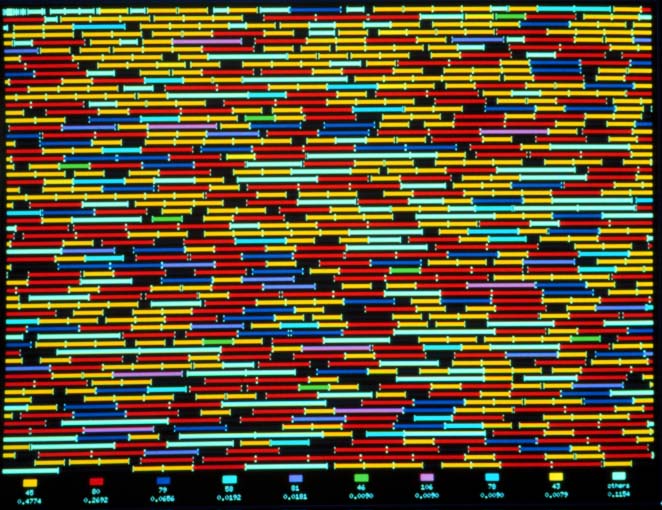
Tierra by Thomas Ray
Therefore, I agree with Whitelaw when he states that “systems are literally texts, involving specific figurations, relations, decisions, values and ideologies”. If we see systems as storybooks, and storybooks comprises text, then we can say that the story in the storybooks are the specific figurations. Tom Ray’s Tierra system is brought in, where Ray’s biological and theological analogies are spelled out in the narration and the construction of the visualisation.

John Holland’s ECHO
Whitelaw also brings up a-life science, which is a concept brought up by Stefan Helmreich and Katherine Hayles. A reference he makes is to John Holland’s Echo, a platform for creating agent-based a-life simulations; Stefan Helmreich analyses it based on conversations with a programmer and inspection of the code; the observations come as much from the defined formal structures of the software, as they do from the discourse around those structures. A-life science is seen as a deconstructive approach, its systems being fundamentally narrative in their operation. They are the embodiment of subjectivity, gender, family and theology, decoded in part from the discourse around the software system. This is just like Whitelaw’s interpretation about how systems are like texts; we can read systems as stories. However, these stories are quite subtle, since the narration is embedded in the code that is hidden from public view. The “system story” translates or narrates the processual structure, ontology, entities and relations in a software system.
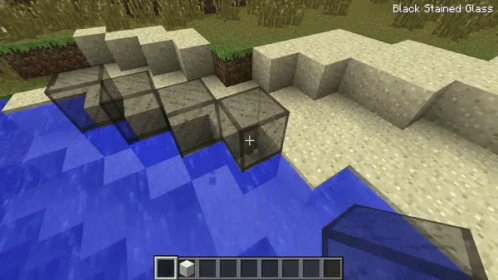
Minecraft Building Blocks
Hence, results and final appearances mean nothing without the systems that created them. These systems tell us a story or narrative. Just like Brad Borevitz says, simulations are merely to abstract them and play with them according to the demands of an aesthetic production. The work is entirely shaped by the construction of its underlying system, its configuration of entities and relations. Generative art is essentially about creating a whole artificial world like Minecraft and showing people how it works. With Minecraft as reference, it is not the giant Swedish meatball nor the mansion you have built in the game that matters; it is the process of gathering materials and resources to build the meatball or mansion that is to be appreciated as generative art.
Whitelaw proceeds to talk about combinatorics or the playing out of permutations to make generative art, which is the opposite of Generative art’s complex systems. This is the questioning of the shape of the system, the question of interpreting, or responding to the configuration of entities and relationship in the code. The results from these are visually complex, but the underlying system is quite simple. These forms and patterns generated were deterministic, in the sense that they were sure to provide a certain sort of result. However, they were impossible to predict exactly despite having fixed systems. This unpredictability is what gives rise to more stories.

Casey Reas’ Software {Structures}
An example of this is Casey Reas’ Software {Structures}: Reas’ #002 and #003, Tarbell’s #003A and #003B, and Ngan’s #003B. In this project the artist’s focus was reflexive and processual: considering the “natural language” specification of a structure, and its varied implementation. Removed from that context, however, we are faced once again with the shape of the system, and the question of interpreting, or responding to that configuration of entities and relations. The model worlds in these instances are pure machines, clockwork constellations.
Physical simulation is then brought in the text to compare against software art, where the systems were usually digital in effect. Physical simulations were pragmatic and effective, creating complex, dynamic interactions between elements at low computational cost. For physical simulations, there is immediate physical resonance, inherently narrative and metaphorical. Mark Napier and Scott Snibbe’s works in the CODeDOC project were brought in for comparison. This is to prove that generative art does not necessarily succeed only in the digital realm; it is also important in the physical sphere as long as there is a process and interaction between different elements of the art piece.
Further in chapter 3 of the text, Whitelaw talks about how results are “organic” and “cellular”, because entities get to “experience” and “choose” which way to go at intersections. This is a symbolism of progression of a narrative. Generative art makes use of multi-agent systems, where entities are explicitly defined and visualised to encode an ontology, a structure of entities and relations, which must be read as the core of the work. These entities have static properties and behaviour over time, which means that history is often absent. “History” will only exist when these entities are introduced to each other to create a catalyst which will elicit the gears of a system to move. In a sense, these can be termed as agent-based systems, where it presents specific attributes and modes of being and relationships between individuals, groups, and the environment.
On this kind of dependent system, where agents meet the environment to run the system, power relations never emerge because there is no “leader” in the system. I think that this is key in generative art because the idea of unpredictability and randomness is that we cannot figure out what will happen, hence having no “leader” is important. There should not be a leading feature that signals the next happenstance, or it will ruin the whole idea of generative art being a work that is special because of how it happens.
Chapter 4 talks about generative software art, as Whitelaw explains, as a potential platform for telling system stories that are more sophisticated, critical, or experimental. It has potential to provide a visual of the systems we live in. In this case, there is no agents-meet-agents story. There is a disconnection between agent and the environment, where agents interact with each other but have no functional impact on their world. These agents lose their individuality when they intersect with each other. In other words, the agents do not have links to each other until they are able to interact with each other, which will spur on a catalyst for the system to go into operation, which is why interaction is more important than the by-product or the pre-product of the experimental art.
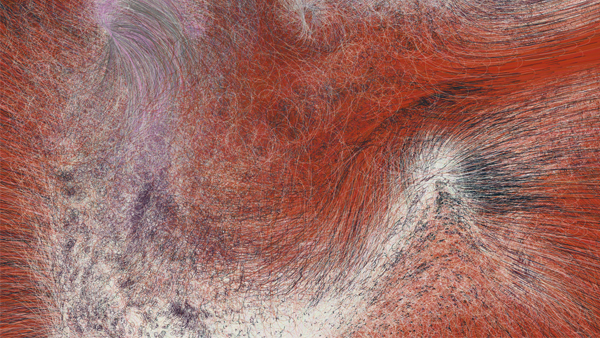
Casey Reas’ Microimage
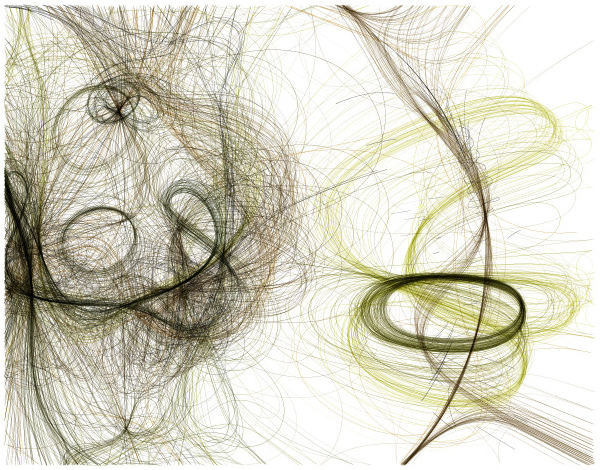
Casey Reas’ Tissue
Whitelaw brings up Casey Reas’ works in Tissue, Microimage, Articulate, TI and Cells. Tissue and Microimage in particular begin to develop the homogenous swarm, creating distinct “species” of agent with distinctive (but again fixed) relationships. The added complexity of the interaction within the system is revealed in the images, as tangled clouds resolve into dark loops and braids. This is the case where agents themselves are individual until they meet each other, where in this case begin to become tangled clouds that creates a new aesthetic for the artwork.
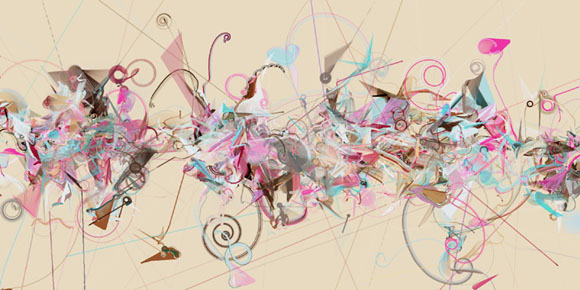
Ichitaro Masuda’s Haohao
Ichitaro Masuda’s Haohao has multiple species of agent, differentiated in size and colour, and attracted to and repelled from each other to varying (randomised) degrees. There is no agent-meets-agent story. When the forces of attraction and repulsion meets equilibrium, the agents form clusters of give or more which might orbit other groups and might change unpredictably if disrupted by an invading agent.

Mauro Annunziato’s Artificial Societies
Mauro Annunziato’s Artificial Societies drawings is the final example of agents interacting with each other but have no functional impact on their world. Their character arises from a simple feature of his system in which agents’ paths are drawn into the environment, and where agents also “die” once they interact with each other. Equipped with a simple genetic/ evolutionary mechanism, the agents progressively divide their environment into isolated “habitats”, each applying a particular selection pressure to the agents within it.
Ultimately, Whitelaw wants us to understand that an environment is not the blank space we usually visualise, which can only bear meaning once there are subjects defining what the space is for. Environment in generative art is instead something that encompasses a system’s history to create results. The environment in this sense, is the system of the code.
Finally, we can decompose a system and analyse the modes of being and relation that it encodes in a generative art system. However, we have little say in how the encodings play out and how they function during the operation. Whitelaw terms this as “computational sublime”, where it is an emergent generativity; it generates art as it emerges. Moving back to the previous concept of a-life, it does not provide increasingly accurate simulations of an authorised “life”, but instead provides experimental and reflexive performances of possible lives.
Axis – Interactive Art by Golan Levin and Collaborators
The important thing about generative art is its structures and properties. These factors are the things that can be tinkered with to change a system and the way it operates, hence leading to the creation of different worlds. Generative art or abstract software art is a potential alternative of stories, and also toying with complex, dynamic systems to generate new model worlds. An example is Golan Levin’s Axis applet, which abstracts political rhetoric into a database-driven combinatoric. It draws its algorithms from the same source, extrapolating, diverting or visualising rhetorical entity and relation structures. This is the proof that we should reconsider the difference between critical, reflexive cultural software art, versus the utilitarian, un-reflexive, result-oriented generative art.
Overall, I really like the idea Whitelaw establishes in his research, where software code is seen as narrative, and where the process matters more than the results. I am someone who really love reading and creating stories, and I think looking at the technicality of software coding is really draining at times. It is mathematical, dry, and formulative. It does not appeal to me as an artist because of the precision it requires. However, when we look at the code as a narrative that gives birth to endless unexpected derivatives, it does not seem as strict and static anymore. An artwork is shrouded with an air of mystery and curiosity, even if it is technical.
Furthermore, it relates to my final project because of the unpredictability of the event, despite being coded beforehand. As my project is about having unpredictable follow-up stories from options chosen by the reader to proceed the story, I think it gels very well with the idea that the code is a text that forms a narrative. In my case, there is a parallel between the software code I am using (HTML) and the story I am crafting. They are both narratives; one is a technical story that decides how the algorithm of the story will appear, and the other an actual unpredictable storyline. Ultimately, I feel strongly for the condition that narratives are the basis of generative art, where it crafts the essence of the artwork for public appreciation. It is not like normal arts where the results are what matters, be it a graphic design or a film. Generative art in interactive media is probably one of the only mediums where the process is the art piece.


A very good reading reflection.
You have chosen the right paper: relevant to your approach and informative for your generative artwork.
Narrativity unfolds around any interesting artwork, regardless of its type or medium, through direct experience, interpretation, reflection and broader impact of the work, although it is accentuated or pronounced differently in different kinds of artworks. In a way, narrativity is what the term “interesting” implies, from Latin inter esse = being (engaged) in or into.
In your live presentation, please find a way to show and discuss all or as many as possible of the examples you posted.
Please make sure to correct the links to John Holland’s ECHO and Golan Levin’s Axis.